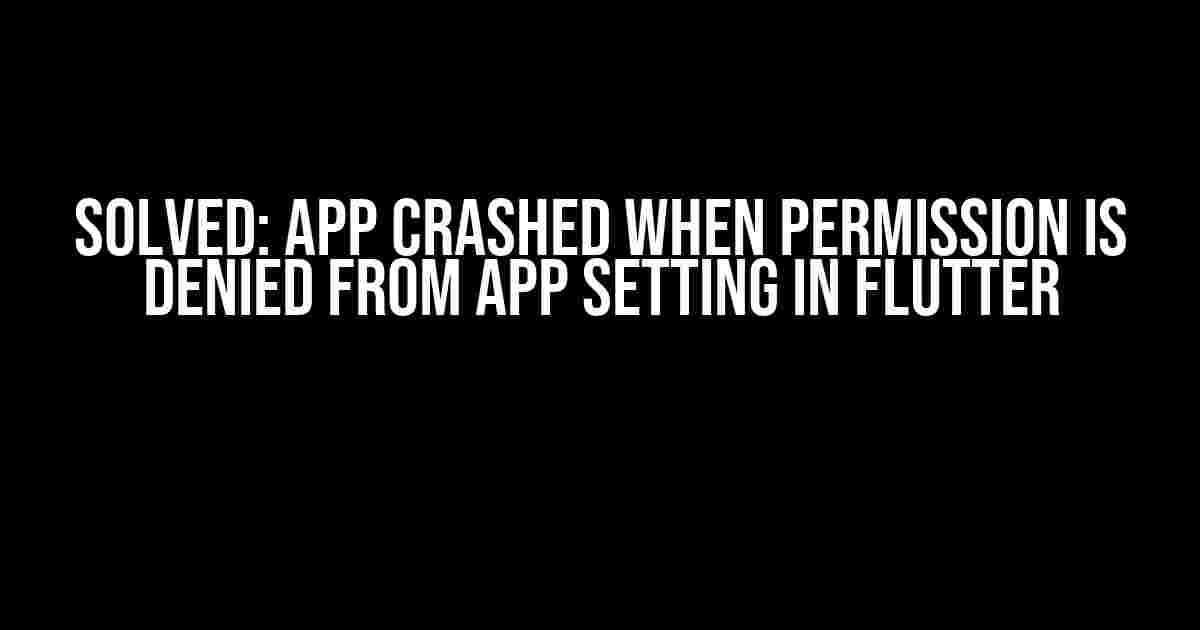Are you tired of dealing with annoying app crashes in your Flutter application? Do you find yourself pulling your hair out when users report that your app is crashing after denying permission from the app settings? Well, worry no more! In this comprehensive guide, we’ll dive deep into the world of permissions in Flutter and explore the reasons behind these crashes. More importantly, we’ll provide you with step-by-step instructions to fix this issue once and for all.
The Problem: Why Does My App Crash?
When a user denies permission from the app settings, your app might crash due to the way Flutter handles permissions. By default, Flutter assumes that the user has granted the necessary permissions, and when this assumption is wrong, the app crashes.
Understanding the Permission System in Flutter
In Flutter, you can request permissions using the permission_handler package. This package provides a simple way to request permissions at runtime. However, when the user denies permission from the app settings, the permission_handler package doesn’t provide a clear way to handle this scenario.
import 'package:permission_handler/permission_handler.dart';
void requestPermission() async {
await Permission.storage.request();
}In the above code snippet, we’re requesting the storage permission using the permission_handler package. However, when the user denies this permission from the app settings, our app will crash.
The Solution: Handling Permission Denial
To fix the app crash issue, we need to handle the permission denial scenario. We can do this by checking the permission status before performing any action that requires the denied permission.
Checking Permission Status
We can use the permission_handler package to check the permission status. Here’s an updated version of the previous code snippet:
import 'package:permission_handler/permission_handler.dart';
void requestPermission() async {
var status = await Permission.storage.status;
if (status.is Denied) {
// Handle permission denial
} else {
// Permission is granted
}
}In the above code, we’re checking the permission status using the status property. If the status is isDenied, we can handle the permission denial scenario.
Handling Permission Denial
Now that we’ve checked the permission status, we need to handle the permission denial scenario. We can do this by providing a clear error message to the user or by requesting the permission again.
import 'package:permission_handler/permission_handler.dart';
void requestPermission() async {
var status = await Permission.storage.status;
if (status.isDenied) {
// Show an error message to the user
_showErrorMessage();
} else {
// Permission is granted
}
}
void _showErrorMessage() {
showDialog(
context: context,
builder: (context) {
return AlertDialog(
title: Text('Error'),
content: Text(' Permission is denied. Please enable it in the app settings.'),
actions: [
FlatButton(
child: Text('OK'),
onPressed: () {
Navigator.of(context).pop();
},
),
],
);
},
);
}In the above code, we’re showing an error message to the user when the permission is denied. This error message provides a clear instruction to the user to enable the permission in the app settings.
Best Practices for Handling Permissions in Flutter
To provide a better user experience, it’s essential to follow some best practices when handling permissions in Flutter:
- Always check permission status before performing any action that requires the permission. This ensures that your app doesn’t crash when the user denies the permission.
- Provide clear error messages to the user when permission is denied. This helps the user understand what’s happening and how to fix the issue.
- Request permissions only when necessary. Don’t request permissions that your app doesn’t need. This reduces the chances of the user denying the permission.
- Use the
permission_handlerpackage correctly. Make sure you’ve added the necessary permissions in the AndroidManifest.xml file (for Android) and the Info.plist file (for iOS).
Common Mistakes to Avoid
When handling permissions in Flutter, it’s essential to avoid some common mistakes:
- Not checking permission status before performing any action that requires the permission. This can cause your app to crash when the user denies the permission.
- Not providing clear error messages to the user when permission is denied. This can confuse the user and lead to negative reviews.
- Requesting permissions that your app doesn’t need. This can lead to the user denying the permission, which can cause issues in your app.
Conclusion
In this comprehensive guide, we’ve explored the reasons behind app crashes when permission is denied from the app settings in Flutter. We’ve also provided step-by-step instructions to fix this issue and handle permission denial scenarios. By following the best practices and avoiding common mistakes, you can ensure that your Flutter app provides a seamless user experience even when the user denies permission.
| Methods | Description |
|---|---|
Permission.storage.request() |
Requests the storage permission at runtime. |
Permission.storage.status |
Checks the permission status. |
isDenied |
Checks if the permission is denied. |
By following the instructions in this guide, you can ensure that your Flutter app is robust and provides a great user experience even when the user denies permission.
Happy coding!
Last updated on: March 12, 2023
Frequently Asked Question
Are you struggling with your Flutter app crashing when a permission is denied from the app settings? Don’t worry, we’ve got you covered! Here are some frequently asked questions and answers to help you troubleshoot the issue.
Why does my Flutter app crash when a permission is denied from the app settings?
This is because when a permission is denied, the operating system sends a callback to your app, and if your app is not handling this callback correctly, it can lead to a crash. You need to make sure that your app is handling the permission denial callback properly.
How can I handle the permission denial callback in my Flutter app?
You can handle the permission denial callback by overriding the `onRequestPermissionsResult` method in your FlutterActivity or FlutterFragment. This method is called when the user grants or denies a permission request.
What is the difference between `onRequestPermissionsResult` and `onRequestPermissionResult` in Flutter?
`onRequestPermissionsResult` is a method in the FlutterActivity or FlutterFragment that is called when the user grants or denies a permission request, while `onRequestPermissionResult` is a callback method in the `PermissionHandler` class that is called when the permission request is complete.
How can I request a permission in my Flutter app without crashing when it’s denied?
You can request a permission using the `requestPermission` method of the `PermissionHandler` class, and then handle the result in the `onRequestPermissionResult` callback method. Make sure to handle both the granted and denied cases to prevent your app from crashing.
What are some best practices to follow when working with permissions in my Flutter app?
Some best practices to follow when working with permissions in your Flutter app include: only requesting the necessary permissions, explaining why your app needs the permission, handling both the granted and denied cases, and providing an alternative flow when a permission is denied.


